'Once you start to collect memorabilia, you can't stop': Meet the collectors archiving Singapore's history


Face it — those rooms filled with Coca-Cola keepsakes, the cabinets with G.I. Joes, drawers filled with back scratchers.
To the rest of us, collectors of memorabilia from the arcane to the everyday can be a little hard to identify with.
But if they can seem a little obsessive to many, to museums and archives the world over, collectors are appreciated as a valuable resource of history as lived by ordinary people.
While no one has collected any local statistics, a 2021 survey by American business intelligence company Morning Consult found that one in three adults in the US collects some kind of physical item as a hobby or investment, with 10 per cent of respondents considering themselves avid collectors.
Make no doubt, there are serious collectors among us.
Communications professional Jian Yang, 44, owns one of the world's largest Barbie doll collections — more than 12,000 dolls, some worth as much as $25,000.
Then there is Chang Yang Fa, a former electrical engineer who founded the Mint Museum of Toys in Seah Street.
The largest vintage toy museum in Asia, it showcases more than 50,000 old-time toys and collectibles.
Experts say the reasons people collect are as varied as the collections themselves.
Some are driven by nostalgia, wanting to reconnect with their past.
Others aim to build a legacy, hoping to pass their treasures down to future generations.
Whatever their reasons, avid collectors share the common trait of being so caught up in the thrill of the hunt that they will devote time, energy and resources to it.
For Hong Tuck Kun, a retired banker and avid stamp collector, collecting is a form of therapy.
"This is my way of releasing stress. When I arrange the stamps, when I research, when I come across a new discovery, it is very therapeutic," says the 71-year-old.
Some collectors are in it for the profit, others purely for pleasure, but at some point, these two impulses may well intersect.
Zaher Wahab has been a savvy collector of sports memorabilia for the past three decades. It started out as a boyhood hobby.
[[nid:642765]]
"It's my investment. I have had people reach out to me wanting to buy items from my collection for double what I paid," says the 42-year-old educator, whose collection includes medals, pins and competition programmes.
When a good price is offered, he has sold items to other collectors. But more often than not, he turns them down.
Daniel Tham, principal curator for pre-colonial and colonial Singapore at the National Museum of Singapore, believes collectors play an important role alongside museum curators in recording Singapore's history.
"We are all involved in sourcing, documenting and collecting material that has historical, cultural or artistic significance. I see our roles and contributions as complementary," says Tham.
"Collectors are often passionate about specific themes, topics or collecting areas.
"This enables them to collect in a very specialised way, so collectively they deepen the scope of what is collected and preserved in Singapore's history."
The Straits Times tracks down four hobbyist collectors whose collections have become part of the national narrative.
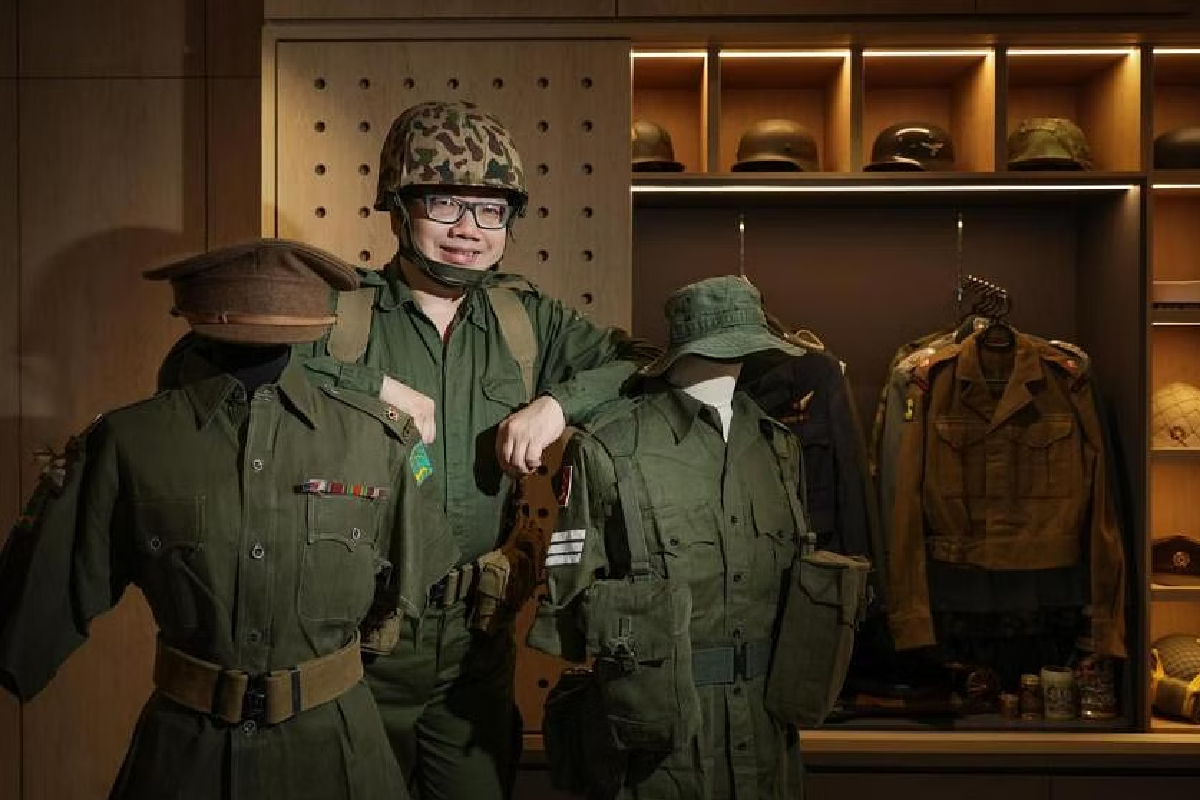
When Alvin Lee, 42, moved into a new five-room flat in Hougang two years ago, he had his interior designer create a special glass display in the living room.
The civil servant also set aside an entire room to store and display his collection of military memorabilia.
It is a collection 30 years in the making and includes over 300 army uniforms from around the world and other military-related paraphernalia such as medals, insignia, ammo pouches and rations.
In total, he has spent more than $150,000 building his collection.
"I've stopped counting a long time ago how many items I have. I'm still buying, but I've lost count because there are just too many," says Lee, who is married with no children.
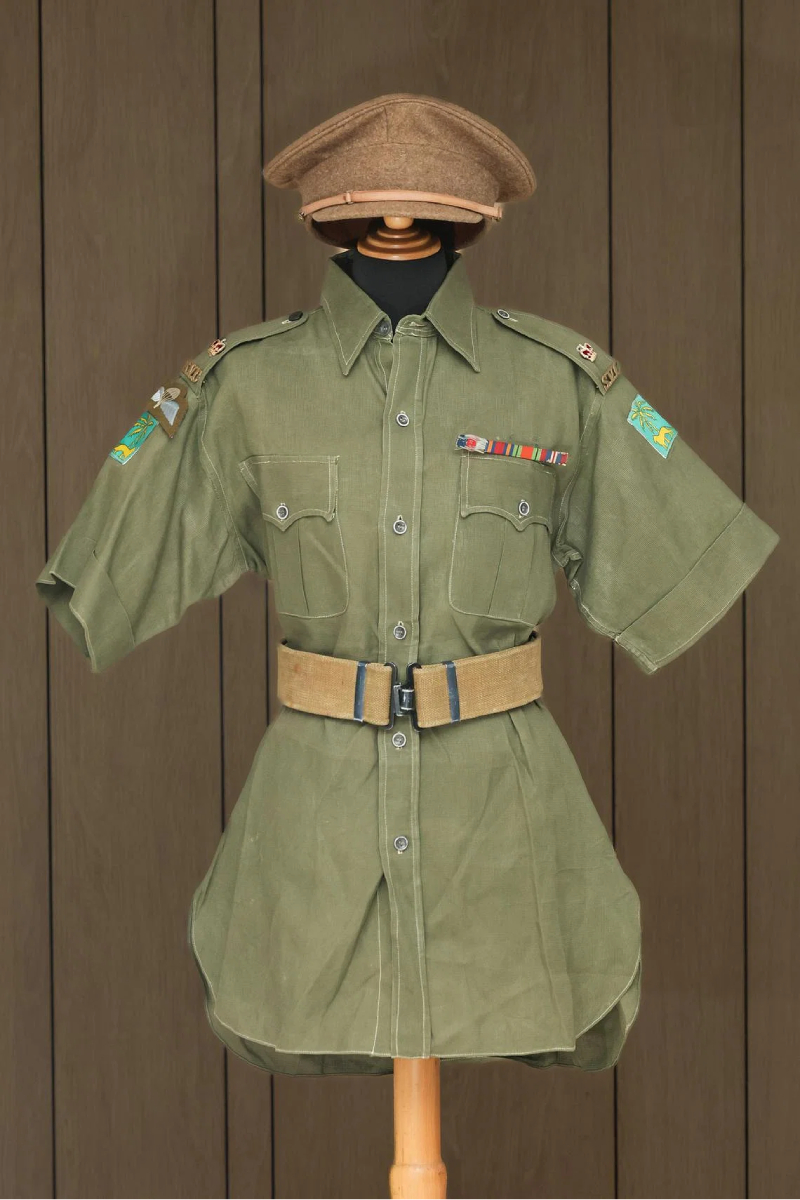
He began assembling and painting German army model kits at 10. He got so good at it, he won a model-building competition, beating much older contestants.
He had combed through military magazines and reference books to ensure his models were as historically accurate as possible.
Then, he started watching war movies that featured American and German armies.
He would spend hours at bookshops browsing through military magazines and World War II books. "I was fascinated with the German military and their helmets stood out. So I started to hunt for one."
He saw an advertisement in a military magazine of a seller in the US selling a German military helmet. He bought it for US$30.
Upon receiving it, he checked it against photos and realised it was not a real German helmet. It was of a similar shape, but was used by a different country during the war. Still, he was hooked.
"Once you start to collect memorabilia, you can't stop. Because you feel like you're doing yourself an injustice if you just stop there. You would want to collect a full set," says Lee.
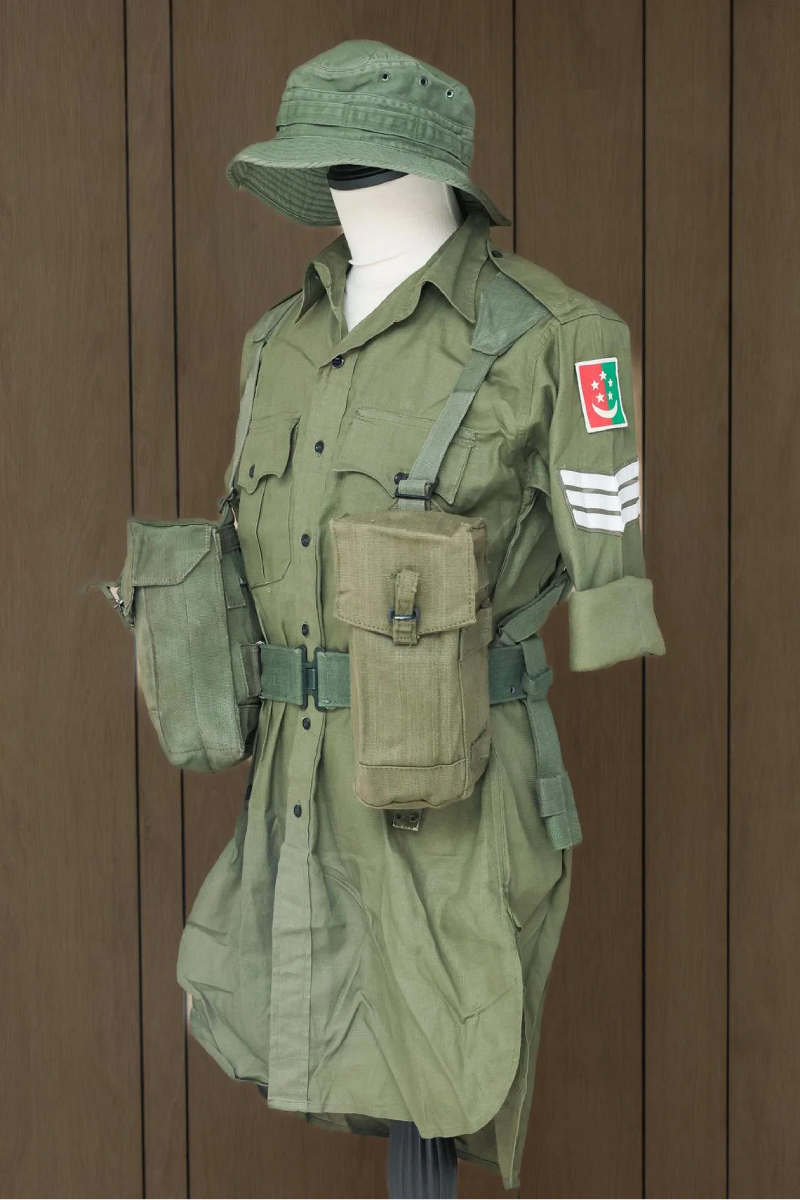
Artefacts are often not as interesting piecemeal as they are part of a complete collection.
Eventually, he found his interest turning mainly to Singapore's military history.
A mannequin in his collection at home wears one of his prized possessions: a Temasek Green uniform from the 1960s, made from thick cotton drill and starched so well it stands on its own.
The Temasek Green was the first uniform of the Singapore Armed Forces (SAF). For a few years beginning in 1967, all military services, namely the army, Republic of Singapore Navy and Republic of Singapore Air Force, wore the same Temasek Green.
But for more than two decades, Lee felt his collection was incomplete, as it was missing one thing: the original camouflage cloth that covered the SAF-issued metal helmet.
He had seen photographs of it wrapped around the metal helmets worn by soldiers in the late 1960s, but had never seen it in real life.
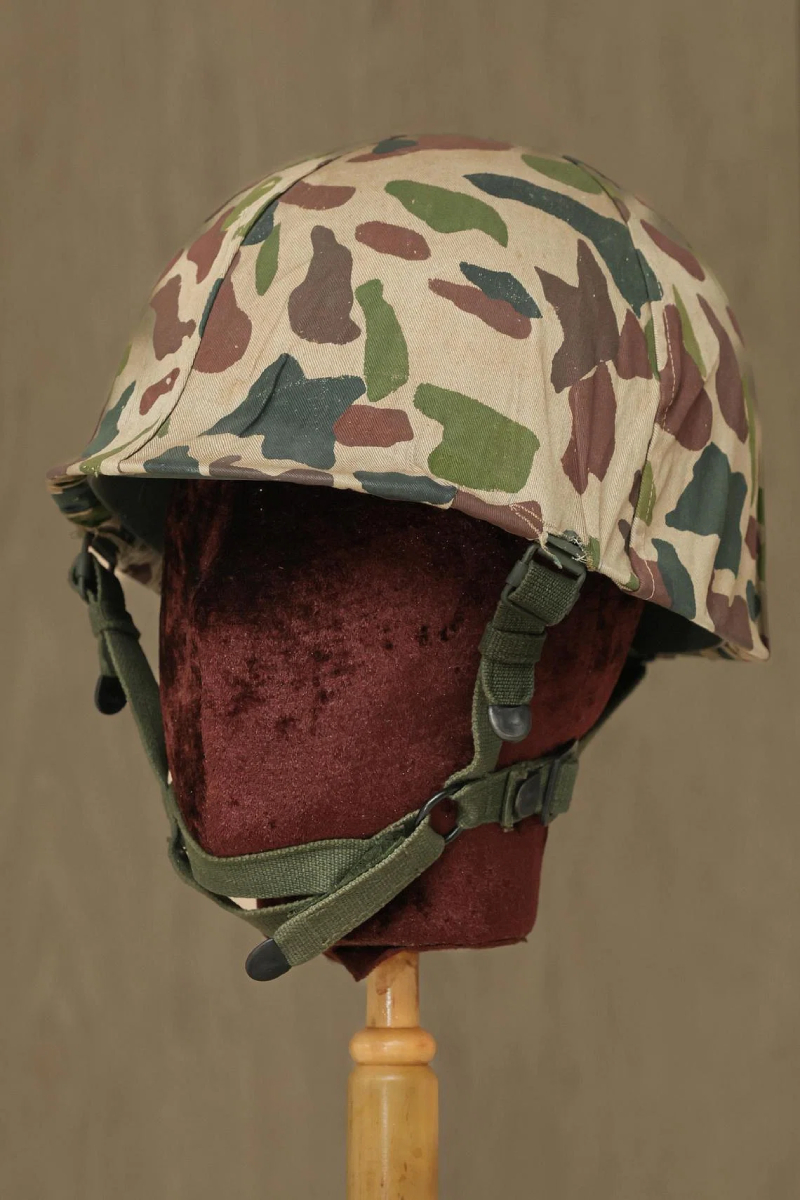
"It's rarer than a unicorn, and I really must have it to complete my early SAF uniform collection," he says.
In March 2022, he hit pay dirt when someone finally contacted him and said he had two of these covers for sale. Lee bought them for $1,200.
Lee has used items from his collection for displays and talks held at various museums like the Singapore Navy Museum, National Museum and the Former Ford Factory, which houses a permanent World War II exhibition.
He has also lent his expertise on military uniforms as a military adviser on local movies like Zombiepura (2018) and 23:59 The Haunting Hour (2018).
Lee reckons his collection will never be complete. "There are so many nationalities, so many military units, so many periods," he says.
He is currently focusing on growing his collection of uniforms, badges and insignia of the Singapore Volunteer Corps and Singapore Military Force.
"These were the British military forces before the SAF and they represent an integral period of Singapore's history that must be preserved."
A 2008 study published in the Journal of Economic Psychology found that while financial gain plays a part, some collectors like Lee are equally motivated by the satisfaction of completing a set when acquiring new items.
They usually start by acquiring individual objects. As their collection grows and a cohesive set emerges, the emphasis shifts from the value of individual pieces to their contribution to completing the entire set.

The year was 1994. Zaher Wahab's father said he would take the 12-year-old to watch the Malaysia Cup final at Shah Alam Stadium in Selangor if he did well in his Primary School Leaving Examination.
So, along with an estimated 60,000 other Singaporeans, father and son made the trip to watch Singapore's national team square off against Pahang.
Singapore beat Pahang 4-0 and clinched its first interstate crown in 14 years, an exhilarating moment that Zaher never forgot.
He kept the ticket and programme booklet from that match. It was the beginning of his lifelong quest to collect sports memorabilia.
"This hobby has allowed me to combine my love for history and my love for hoarding things," says the 42-year-old educator, tongue in cheek.
It meant weekends spent at the now-closed Sungei Road flea market, where peddlers — mostly rag-and-bone men — sold a mind-boggling array of knick-knacks and used items.
He found treasures among what others had considered trash — old sports magazines, sporting competition programme booklets and medals, as well as pins worn by Singaporean athletes.

"Singapore, despite gaining independence only in 1965, has a rich history as we have been participating in sporting events as far back as the 1948 Olympics when Lloyd Valberg marched in proudly as the sole athlete representing Singapore," he says.
"I believe we must honour our past to fully appreciate what we have now."
Valberg, who died in 1997 at the age of 74, was a high jumper and hurdler, and a grand-uncle to Olympic gold medallist Joseph Schooling.
Soon, Zaher expanded his collection to include South-east Asian sports memorabilia, with items from regional sporting competitions such as the SEA Games, which are held every two years.

He has some artefacts in his three-room flat in Clementi, where he lives with his wife and two pet rabbits.
Fragile items are stored in a temperature-controlled storage space that he rents in Changi.
They include a South-east Asian Peninsular (Seap) Games programme booklet from 1959, the first year the Games were held.
This he found on a trip to Myanmar in 2018, combing flea markets that he says are a treasure trove for vintage collectors.
"I could spend a week at Bogyoke Aung San Market in Yangon, just going through stuff," he says.
Today, he has a collection of more than 1,000 items which run the gamut from Olympic pins to sports programmes to jackets worn by national athletes.
He estimates that he has spent more than $25,000 on his collection.
"I have bought some items that have really broken the bank."
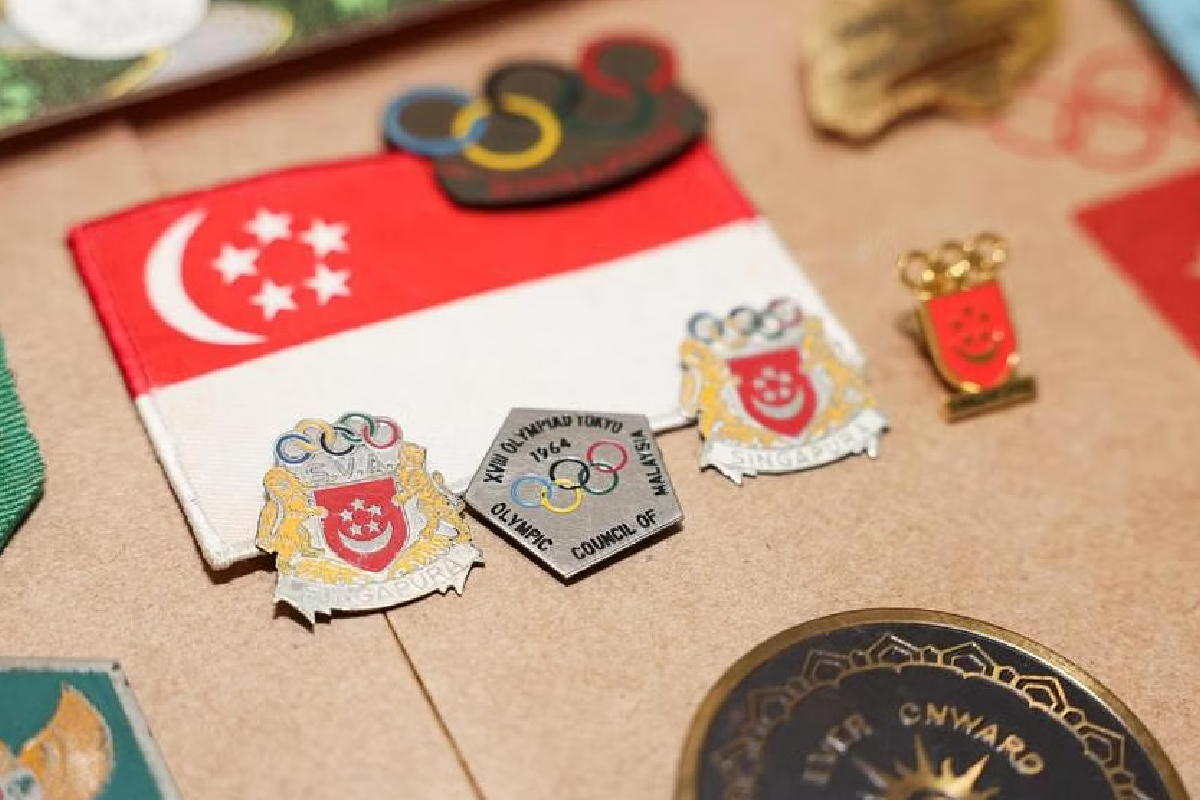
His most prized possessions are a series of Thomas Cup (Badminton) programmes from the first three editions when Malaya dominated the scene.
He bought them in 2015 for $2,000. A few years later, someone offered to buy them for $5,000, but he could not bear to part with them.
Zaher has not been one to let his artefacts gather dust.
He has taken them to schools to illustrate social studies lessons. He has also loaned them to the Singapore Sports Museum for exhibitions, including memorabilia from the 1973 Seap games.
His expertise is also in demand.
In July 2024, with his keen knowledge of the Olympic movement and Singapore's sporting heritage, Zaher was appointed to serve as a board member of the Singapore Olympic Academy, the educational arm of the Singapore National Olympic Council.
In museum curator Tham's experience, collectors like Zaher are eager to share and showcase what they have painstakingly accumulated through the years to a wider audience.
"Telling stories is very important in what we do at the National Museum, so when we engage with collectors or any member of the public, we are always keen to hear the stories that they have about their collections," says Tham.
"This shapes how we contextualise and present collections, which in turn helps collectors see how the items they loan us contribute to a broader narrative."
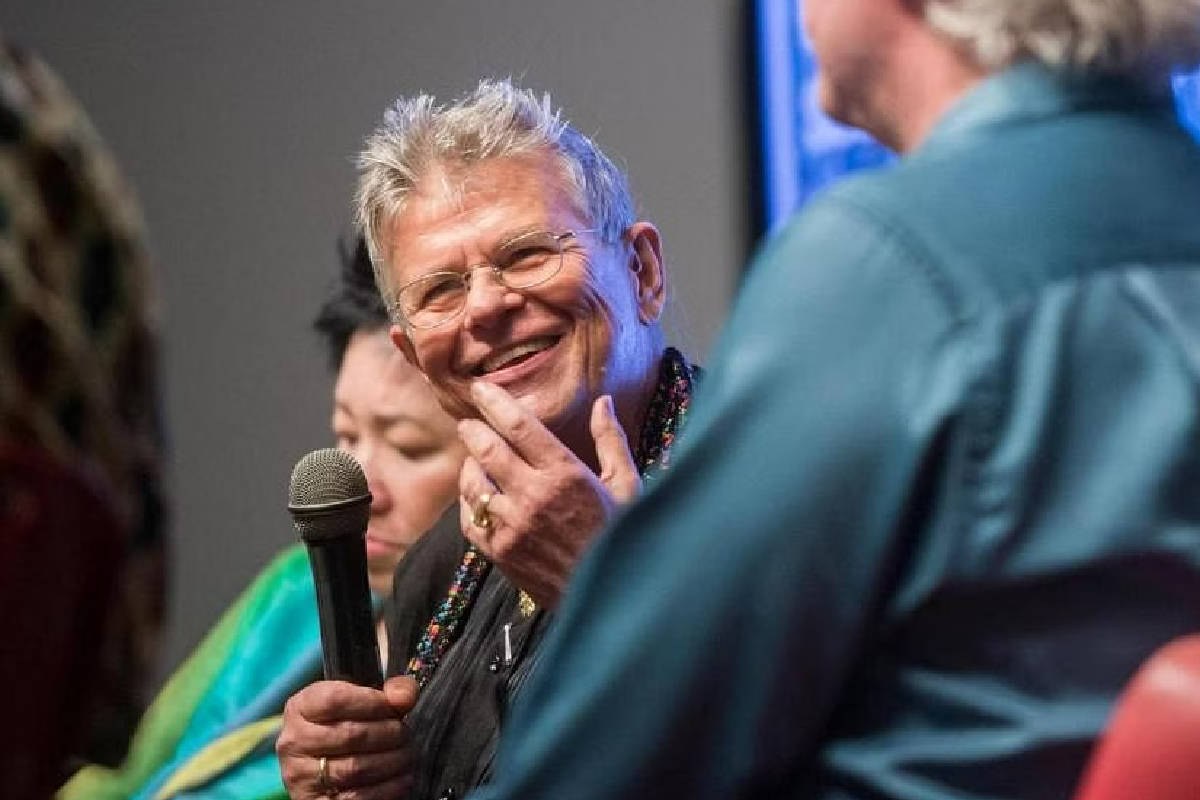
Born in Singapore in 1950 to British parents of Romanian descent, Ronni Pinsler grew up in Orchard Road, in a flat opposite the old Amber Mansions in Dhoby Ghaut.
As a young boy, he would accompany the Cantonese majie (domestic helper), whom his parents hired to look after him, to her village in Changi for festivals. It sparked a lifelong interest in Taoism.
"My parents travelled a lot for work, so she (Ah Toh) often took me back to her kampung to attend festivals and temple celebrations. My interest in things Chinese was probably due to her," says the 74-year-old retired diamond trader.
Till this day, he researches and records legends about deities on his website Book of Xian Shen, which roughly translates to Book of Chinese Deities.
He also runs a Facebook group, Local Gods & Their Legends, which records locally created and lesser-known divinities.
At the age of nine, Pinsler was sent to boarding school in England, returning as a 21-year-old in 1971 to work in his family's diamond trading business.
Back in Singapore, he befriended German travel guide writer and photographer Hans Hoefer, who was updating his travel guide Insight Guides Singapore.
From Hoefer, he learnt the basics of creative photography.
Pinsler then bought himself a Leica camera and started taking photographs as a hobby.
"I always kept the camera in my bag with the diamonds and cash I collected from my day job. I would stop by temples and just kaypoh," he says, joking that his father is not around any more to disapprove.
He started spending more time at Chinese temples across the island.
Besides taking photos, he also took notes on customs, festivals and the birthdays of various gods.
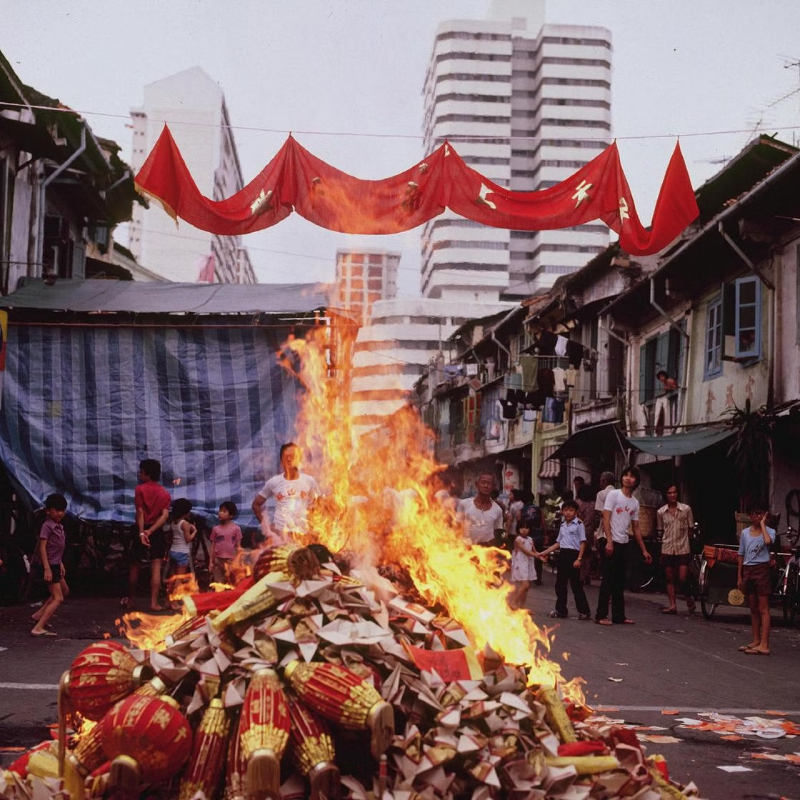
He became friends with devotees, priests and caretakers, who gave him the nickname "Bip Po" — meaning bat in Hokkien — owing to his energetic night jaunts to temples.
"People my age were going out to house parties, I was at the temples," he says with a laugh.
As he photographed temple events and festivals, around him, Singapore was changing rapidly.
Following the formulation of Singapore's first concept plan in 1971, old buildings and shophouses were being torn down to make way for new commercial developments and transit networks.
One day, he saw the old mansion of William Farquhar — a Scottish colonial administrator who became the first Resident Of Singapore — in Oxley Road being torn down without any fanfare.
From that moment, Pinsler vowed he would always have his camera with him.
He estimates that 95 per cent of his photos were for documentary purposes, as he realised they could be the last records of a particular location.
In the 1990s, the then director of the National Archives of Singapore, Pitt Kuan Wah, warned him that his photos — taken on Ektachrome and Kodachrome slides — would deteriorate if they were not stored properly.
If not kept in a temperature-controlled room, these photo slides would discolour and fade. They could also succumb to mould and fungus in the heat and humidity.
"I thought it would be sad to leave the pictures in a light table cabinet and not use them. So I thought I'd better not be selfish about this," says Pinsler, who made the decision to permanently loan his photographs to the National Archives.
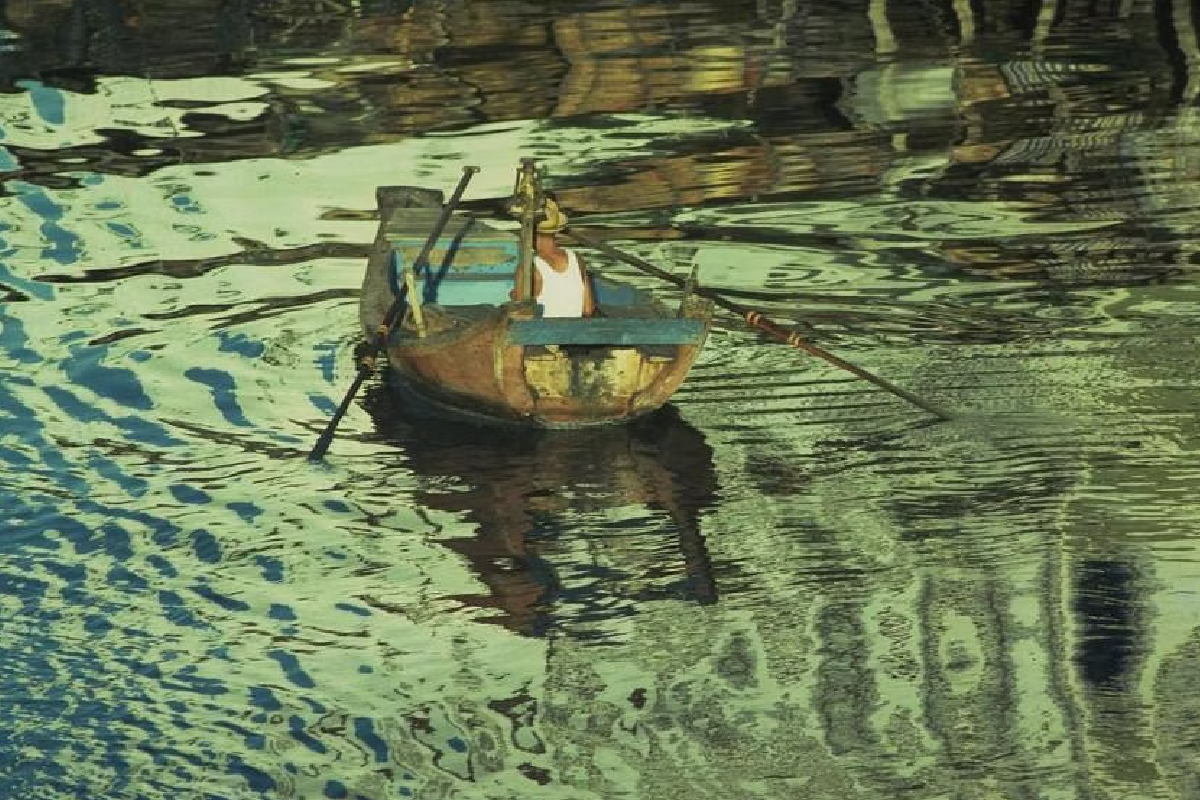
Over three weeks, two staff members from the National Archives went to Pinsler's apartment in Leonie Hill, taking thick plastic sheets to pack the slides in, and getting to work organising and cataloguing his extensive photography collection.
When they were done, he was handed digital copies of more than 16,000 photographs. He went over each one and did his best to caption them — a massive undertaking that took him over a year.
Going through Pinsler's collection of over 16,000 photos in the National Archives' online library — you catch a glimpse of what life was like in yesteryear Singapore, be it through photos of a Chinese opera performer getting ready backstage for a performance, of customers buying satay at a street-side hawker stall, or of half-demolished shophouses along the Singapore River.

Pinsler also handed over a Betamax copy and the film rushes of his 1989 movie Entertaining the Gods about life on the Singapore River.
The documentary was screened in 2017 at a special event hosted by the Singapore Heritage Society.
For the permanent loan of his photographs to the National Archives, Pinsler received the prestigious Supporter of Heritage award from the National Heritage Board in April 2010.
"This is my legacy. I love Singapore, it's my birthplace, my home.
"I always tell people about the esoteric, spiritual quality of Singapore. Beneath this tough exterior skin still exists a lot of magic.
"I think you can find the magic in Singapore if you know where to look," he says.
In addition to books and official documents, the National Library and National Archives store and catalogue materials such as maps, building plans, photographs, newspapers, letters, diaries, menus, brochures, oral histories, soundscapes and websites.
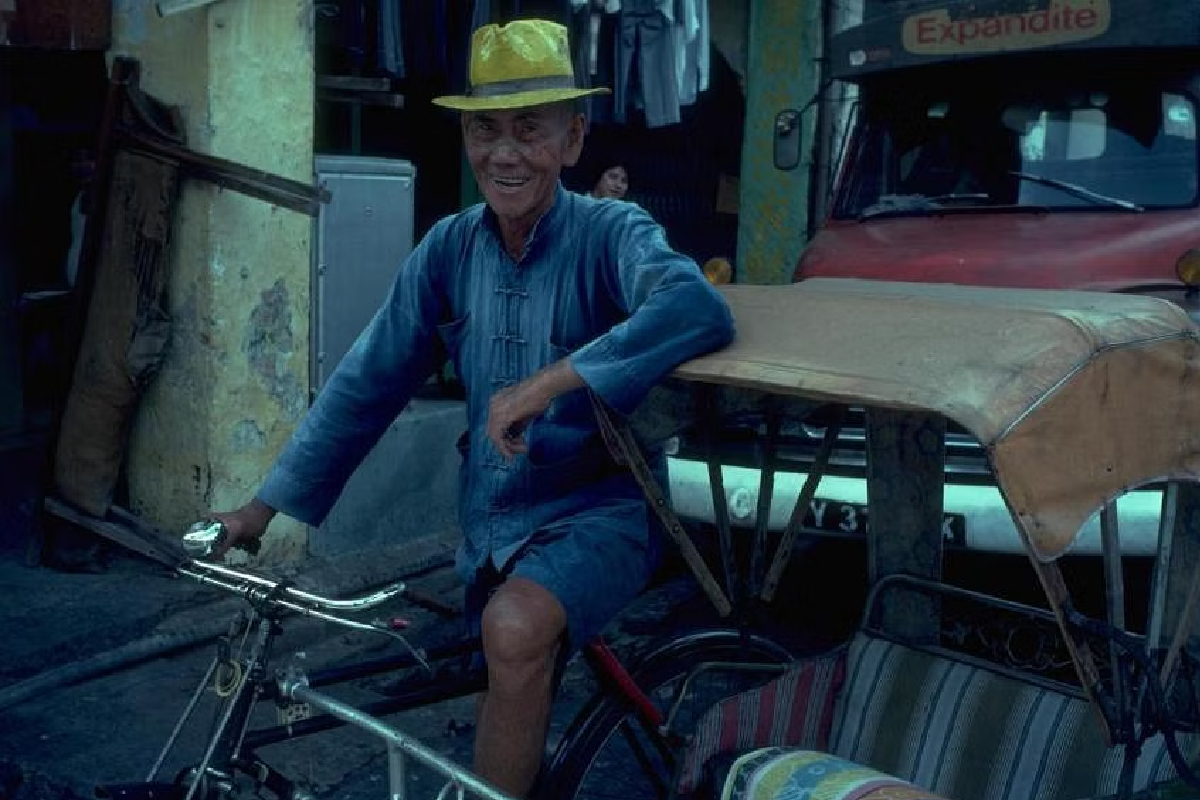
Alicia Yeo, director of National Library at the National Library Board (NLB), says that private collections like the one donated by Pinsler complement collections by institutions under NLB, such as the National Library and National Archives.
NLB identifies individuals or organisations that may have relevant collections and contacts them in an effort to conserve their materials and make them accessible to the public.
Yeo says: "This is in part perhaps why collectors tell us they are confident and willing to donate their collection to NLB.
"These collections tell us more about individual and community experiences, that in turn enrich the Singapore story we can share."

Few may know there was a short period in Singapore's history when letters could be sent without a stamp.
It was September 1945. The Japanese had just surrendered, effectively ending World War II in Singapore.
The British Military Administration took back control of British Malaya, and stamp production was the last thing on their mind.
Despite the absence of stamps, then civil administrator Ralph Hone decided to keep post offices open. Notices were sent out to reinstate pre-war postal workers in their former positions.
Major-General Hone felt it was important to give the civilian population in Singapore a sense of normalcy and enable them to communicate with displaced family and friends.
So for about a month in 1945, stamps were not required when sending a letter from Singapore.

A letter that he wrote to a military colleague in England dated Sept 17, 1945, explaining this decision, is one of Hong Tuck Kun's most prized possessions.
In the letter, Maj-Gen Hone wrote: "I decided to open a free service until the stamps come to hand. I can confess I have done this without the Treasury approval."
He believed the British government would not be happy with his decision, as stamps were an important source of revenue for the postal service.
Hong, a 71-year-old retired banker, has a philatelic collection that fills two rooms in his corner terraced house near Serangoon Gardens that he shares with his wife and two adult children.
He has lost count of how many items he has, but knows they are in the tens of thousands.
"I've spent a lot of money on this. Don't think my wife is very happy," he says wryly.
Hong grew up in Coleman Street, where his family ran a laundry business. He would rummage through dustbins in the nearby High Street, which was then full of shops selling textiles.
Merchants would ship rows and rows of fabric from India, open up the cloth wrappings, and then discard them. To the 10-year-old, the stamps stuck onto the wrappers were treasures.
He wowed his schoolmates with his early collection of Indian stamps. They were big and featured elephants, lions and tigers.

Stamp collectors tend to pick a theme as they start building their collection, with common themes being historical figures, animals, and natural wonders like waterfalls.
Hong has focused his energy on building a Singapore-centric collection.
Over the years, he has gone beyond collecting stamps, to collecting mail, newspaper clippings, and other paper items related to Singapore.
He is particularly interested in linking Singapore's postal history with its social history.
He adds: "You can learn only so much from the history books, but from stamps and letters, you can learn so many more interesting details."
Hong pulls out a mint postcard showing the unveiling of the statue of Sir Stamford Raffles in front of Victoria Memorial Hall in 1919. The postcard states that it used to be at the Padang.
"The same statue is now at Empress Place. Why was it removed from the Padang and relocated?"
His imagination fired, he looked up books on Singapore's history and online resources, eventually finding his answer.
The statue was installed in the middle of the Padang in 1887. To get a better view of football matches being played on the field, spectators would climb on top of the statue. Birds also left droppings on it.
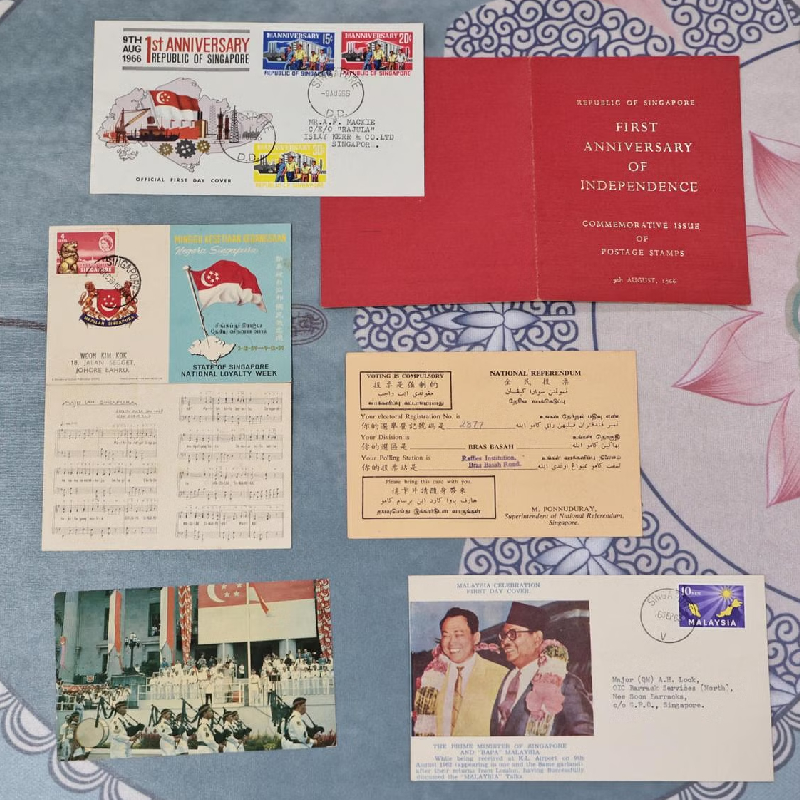
The authorities felt that a more dignified location was required, and during Singapore's centenary celebrations, the statue was moved to a site in front of the Victoria Memorial Hall in Empress Place on Feb 6, 1919.
He found the card on online marketplace eBay a few years ago. A similar card on eBay is currently listed for US$750 (S$995), but he remembers paying a much lower price for his.
"Sometimes, I can't have an item I want immediately and it's a very long time before I acquire it. But when I do, the feeling is amazing," he says.
When the Singapore Philatelic Museum was being set up in 1995, the museum curators reached out to private collectors like Hong to create interesting and educational exhibitions.
Hong became a valuable resource for the museum, lending it stamps for exhibitions over the years.
But in March 2019, the Singapore Philatelic Museum closed, and was redeveloped into the Children's Museum in December 2022.
As post becomes increasingly digital, the circle of stamp and post-related collectors has dwindled.
Since 1968, Hong has been a member of the Singapore Stamp Club, attending club meetings every month. Once numbering in the thousands, the club's membership has fallen to about 200 now.
He accepts the world is constantly changing, but it does not mean he is always on board about it.
"With the advent of the internet, communicating is so much easier. But there is nothing like writing a personal note. How many people archive their e-mails?"
ALSO READ: Are typewriters good investments? Or just nostalgic sentiments?
This article was first published in The Straits Times. Permission required for reproduction.